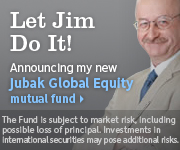Last week’s Heinz deal shows that Warren Buffett is shifting his targets to cope with a more volatile environment. Here are seven more companies that could fit the bill, writes MoneyShow's Jim Jubak, also of Jubak's Picks.
You and I aren’t Warren Buffett, and that means we aren’t going to get the kind of deals that Buffett gets.
Nobody is offering you or me preferred stock yielding 9% in a safe, consumer blue chip, like Buffett got as part of last week’s $23 billion ($28 billion if you include assumed debt) buyout of HJ Heinz (HNZ).
To get 9%, you have to be Warren Buffett, the Sage of Omaha, with a name that brings investment bankers flocking to finance any deal that includes you. (Part of Buffett’s profit from a deal like Heinz is, in essence, a fee for making the financing of a $28 billion deal easier for his other partners.)
But that doesn’t mean you and I have nothing to learn from a deal like this. In fact, I think this one is particularly educational. The Heinz buyout is further confirmation—in case you needed more after looking at Buffett’s other recent moves, like his buyout of railroad Burlington Northern—that Buffett believes in what Pimco bond guru Bill Gross has called “the new normal market” and what I’ve called “the paranormal market.”
The Heinz deal makes the most sense if you see the next decade offering relatively modest returns and a continuation of the high volatility of recent markets. The new normal and paranormal paradigms call for, at best, 5% annual returns from equities.
In the paranormal market, I point to the extreme volatility of 2011 as something we can expect with frequency. (For a description of the new normal and the paranormal paradigms, see my posts Call It the New Paranormal Market and 3 Buys for This New Sideways Market. )
Why do I think the Heinz deal is fit for these kinds of markets? For one, because it’s not the kind of value deal most investors associate with Buffett, though frankly it’s been a long time since he has been a pure value investor.
And because what Buffett is paying up for—what he thinks deserves a premium—is the kind of steady, predictable, somewhat-better-than 5% annual earnings growth that will be hard to find and extremely valuable under the new normal conditions.
Look at a few numbers on Heinz. For the last five years, earnings growth has averaged 7.1% per year. For the next five years, the Wall Street consensus puts earnings growth at 7% annually. The stock pays a dividend of 2.83% a year, and it shows an annual dividend growth rate of 6.3% a year.
For this, Buffett and his co-investor, Brazilian buyout fund 3G Capital, have offered to pay 20 times projected earnings. This is value? Well, yes, if you define value for a new normal/paranormal period.
According to research by Andrea Frazzini and Lasse Pedersen at the investment management firm AQR, Heinz is one of the least volatile big stocks of the last ten years. Its beta is a piddling 0.58%, which means it moves up and down less than the market as a whole. (By definition, the entire market has a beta of 1.)
Despite that lack of volatility—or I should say, in the current period, because of it—Heinz has posted an annual total return of 9.4% over the last ten years. That beats the 6.8% annual return on the Standard & Poor’s 500 Index—and even the 7.2% annual return for shares of Buffett’s Berkshire Hathaway (BRK.B).
The price of the deal reflects that solid, above-market return and what looks like an absolutely predictable cash flow. (A steady cash flow is essential if you own 9% preferred stock, which needs the money to pay out that dividend, even if it is preferred.) After all, even if the stock market tumbles and the economy stumbles, people will buy ketchup and baked beans, right?
What Buffett is willing to pay for this predictability, and this shelter from market and economic volatility, makes more sense once you start looking for other Heinz-like stocks. There just aren’t that many candidates. That’s especially true if you eliminate stocks that Buffett already owns, such as these three:
- IBM (IBM) shows 15.5% annual earnings growth over the last five years and a consensus projection for 9.5% growth over the next five. The dividend is 1.7%, and the annual dividend growth rate over the last five years has been 16.3%.
- Coca-Cola (KO) shows 8% annual earnings growth over the last five years and a projected 8.8% over the next five. The dividend is 2.7%, and its annual growth rate is 8.45% over the last five years.
- Procter & Gamble (PG) shows a 4.7% annual earnings growth rate in the last five years and a projected 8.4% over the next five years. The dividend is 2.9%, and its annual growth rate has been 9.9% over the past five years.
These numbers look very similar to those for Heinz. So other than these three, who else fits the bill?
NEXT: 4 More Buffett-Worthy Stocks
|pagebreak|4. McDonalds
With 15% annual earnings growth over the last five years and a projected 9.8% for the next five, perhaps McDonald’s (MCD) does. The dividend yield is 3.3%, and its growth rate has been 13.9% annually over the last five years.
The stock is likely to be more volatile than Buffett might like over the next quarter or two, as the company laps some tough growth comparisons, but after that it would seem to be a good candidate for the club. (McDonald’s is a member of my Jubak’s Picks portfolio.)
5. DaVita
I’d call DaVita HealthCare Partners (DVA) another potential Heinz-like stock in the making. The kidney dialysis market is growing at an almost certain 4% a year, as more and more of the US population develops diabetes.
DaVita’s earnings growth rate over the last five years is an annual 15.1%, and the consensus annual growth rate for the next five years is 12.7%. The stock doesn’t pay a dividend. Buffett has been accumulating shares of DaVita at a steady pace in recent quarters.
Though the shares trade at just 15.5 times projected earnings, I’d still be cautious on DaVita over the next few months. It gets much of its reimbursement for dialysis services from the federal government (66% of revenue comes from Medicare and Medicaid), and payment rates are definitely at risk if the threatened budget sequester goes into force. (Rates for bundled services that include dialysis and a diabetes drug took a cut in the fiscal cliff settlement.)
It’s possible that DaVita will show a miss in the next quarter or two, if its ability to cut costs to preserve margins ends up lagging changes in government policy. But any miss would likely be a short-term problem because DaVita has a history of effectively cutting costs to preserve margins, and its size gives it substantial bargaining power with suppliers.
6. Abbott Laboratories
Another Jubak’s Pick, Abbott (ABT) is tough to put numbers on after its January breakup. But the Abbott Laboratories piece picked up much of the company’s predictable, high-growth businesses, such as nutritionals, where sales grew 8% in 2012.
If the new company can deliver the cost reductions and margin increases that Wall Street expects—a roughly 5-percentage-point improvement in margins by 2016—this will also fulfill its promise and become a Heinz-like stock.
7. Yum Brands
This stock belongs in the group, too, if it can correct the big hit it took to growth in China when suppliers to its KFC chain were found to have sold the company chicken with levels of antibiotics that exceeded government health standards.
This has turned into a major marketing debacle for Yum! (YUM), resulting in Chinese customers questioning the quality of its food and staying away from KFC in droves. The company has projected a 25% drop in same-store sales in China in the first quarter, a big problem because China represented 42% of operating profit in 2012.
The risk here is that Wall Street is still underestimating how long it will take to restore customer faith in KFC. I’d wait for more information on how sales are trending in the remainder of this quarter and into the spring. But this is certainly a potential Heinz-like stock once Yum! gets past this problem.
You may have to wait a quarter or so on some of these before you’ve got enough information and the right price to make a buy. But we can afford to be more patient than Buffett right now. We don’t have $48 billion in cash demanding to be put to work in something.
Thank goodness for that, right?
Full disclosure: I don’t own shares of any of the companies mentioned in this post in my personal portfolio. All my personal portfolio is invested in the mutual fund I manage, Jubak Global Equity Fund. That fund may or may not now own positions in any stock mentioned in this post. For a full list of the stocks in the fund as of the end of September, see the fund’s portfolio here.






















